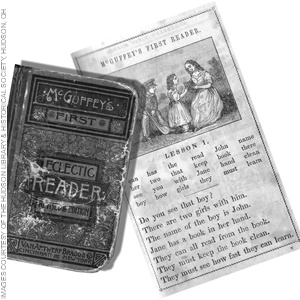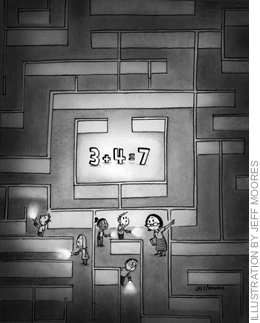 Emma attends a school where more than 95 percent of the students achieve at grade level, including Emma. But listen to Elaine, her mother: “This is such a bad school. I’m sorry, but it is.” A bold statement made by a small, stay-at-home mother who regularly cuts conversations short because she is uncertain whether her concerns are worth the air time. Today Elaine has something to say, and she is saying it out loud, on the playground, and we all listen. Her child, a creative, bright-by-any-measure child, “just missed” the high math group last year, and Elaine did not realize the consequences until it was too late.
Emma attends a school where more than 95 percent of the students achieve at grade level, including Emma. But listen to Elaine, her mother: “This is such a bad school. I’m sorry, but it is.” A bold statement made by a small, stay-at-home mother who regularly cuts conversations short because she is uncertain whether her concerns are worth the air time. Today Elaine has something to say, and she is saying it out loud, on the playground, and we all listen. Her child, a creative, bright-by-any-measure child, “just missed” the high math group last year, and Elaine did not realize the consequences until it was too late.
“I kept thinking [the teacher] would do the right thing for Emma. She was so nice and friendly. I thought she recognized Emma’s talents. But it never happened. Emma was losing her self-esteem.” Self-esteem seems mushy until you see what it means for Emma, who now believes she can’t “do math.”
And what about Jacob?
Jacob’s mom, Veronica, was single, worked two jobs to make ends meet, and refused to take free school lunches even when she qualified. Her son’s district was offering a new choice plan and Jacob, African-American, tested at 110 percent of average. Though Jacob’s school had won a national award for its work with poor and minority children and the principal was kind to Veronica and Jacob, Veronica had a nagging feeling that something was not right.
At Veronica’s request, we looked at the numbers and found that the school’s scores, by any measure other than a relative one, were abysmal. Four out of every ten students like Jacob-eligible for free lunch-were failing. Moreover, a scant few scored at the tier above grade level.
Jacob was capable of much more-his achievement despite great obstacles showed that. His mother knew he needed more. His school was content with less.
Emma and Jacob ride the powerful education sea. It ebbs, shifts, creates opportunities-and can destroy them. Policymakers and administrators, like waves, come and go. Their reforms affect Emma and Jacob, but they are not really made for these particular children at all. An individual child’s success and joy-even in learning-do not direct the sea.
Parents stand ashore, typically with the right compass, but rarely with a choice about which vessel might take their kids where they need to go. Meanwhile, waves of well-intentioned policies carry their children this way and that. While these policies may work for some children some of the time, they rarely meet the needs of all.
We wish we could tell you that Emma’s school is firmly committed to tracking, and that’s why she was passed over; that a simple change of school or district policy would do the trick. But not so. In fact, her district “mandates” differentiation-flexible, changing work at each child’s level-to ensure that every child is challenged and successful.
But a mandate is no match for habit. And choice, as Jacob’s mother discovered, is no good in the absence of good information.
Parents like Elaine and Veronica, and the stories they tell about their children, should change our measure of school excellence. They are not ideologues. They have no political agenda. They are guided by one compass-their children-as they navigate the education sea. Why can’t schools do as well?
Bryan C. Hassel and Emily Ayscue Hassel are coauthors of Picky Parent Guide: Choose Your Child’s School with Confidence, The Elementary Years, K-6 (Armchair Press 2004) and codirectors of Public Impact, an education policy and management firm. The Hassels have two school-age children of their own.





